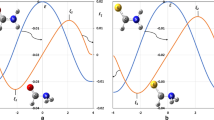Abstract
Covalent bonding has been found to be related to the relaxation of dynamical constraints on electronic motion in atoms and molecules. The corresponding strain energy in an atom is therefore a measure of its inherent reactivity. Here, such reactivities of the atoms H through Ne are estimated by the use of the Thomas–Fermi density functional theory which can be simply implemented using parametrized exponential electron densities in two different forms—the traditional form assuming complete ergodicity and a modified form which accounts for nonergodicity and therefore strain. The Thomas–Fermi functional is amended by the incorporation of gradient correction of the kinetic energy according to the von Weizsäcker prescription. This correction, implemented within the nonergodic form of the Thomas–Fermi theory, is scaled to yield total atomic energies in agreement with the Hartree–Fock results. The scaling factor shows a variation from around 0.07 for Be to 0.1 for Ne. The reactivity, measured by the stabilization brought by going to the ergodic form of quantization within the Thomas–Fermi theory, is zero for He and Ne and shows a broad peak around oxygen in apparent agreement with chemical intuition. Molecular bonding efficiencies are studied for some small molecules and are found to be relatively large for hydrides and smaller for diatomic molecules such as Be2 and F2.
Similar content being viewed by others
References
Esterhuysen C, Frenking G (2004). Theor Chem Acc 111:381
Nordholm S (1987). J Chem Phys 86:363
Nordholm S (1988). J Chem Educ 65:581
Lewis GN (1916). J Am Chem Soc 38:762
Moore WJ. (1972) Physical chemistry, 5th edn. Prentice Hall, New Jersey
Parr RG, Yang W (1989) Density functional theory of atoms and molecules. Oxford University Press, Oxford
Gunnarsson O, Lundqvist BI (1976). Phys Rev B 13:4274
Vosko SH, Wilk L, Nusair M (1980). Can J Phys 58:1200
Becke AD (1993). J Chem Phys 98:5648
Kohn W, Sham LJ (1965). Phys Rev 140:A1133
Thomas LH (1927). P Camb Phils Soc 23:542
Fermi E (1927). Rend Acad Lincei 6:602
Teller E (1962). Rev Mod Phys 34:627
Hellman H (1928). Z Phys 48:73
Hellman H (1937) Einfürung in die Quantum Chemie. Franz Deuticke, Leipzig
Ruedenberg K (1962). Rev Mod Phys 34:326
Ruedenberg K (1975) In: Chalvet O, Daudel R (eds) Localization and delocalization in quantum chemistry. Reidel, Dordrecht, p 223
Bacskay GB, Reimers JR, Nordholm S (1997). J Chem Educ 74:1494
von Weizsäcker CF (1935). Z Phys 96:431
Cummins PL, Nordholm S (1984). J Chem Phys 80:272
Yang W, Parr RG, Lee C (1986). Phys Rev A 34:4586
Chan GK, Cohen AJ, Handy NC (2001). J Chem Phys 114:631
Fraga S, Karwowski J, Saxena KMS (1976) Handbook of atomic data. Elsevier, Amsterdam
Lide DR. ed. (2003) CRC handbook of chemistry and physics, 84th edn. CRC, Boca Raton
Frisch MJ, Trucks GW, Schlegel HB, Scuseria GE, Robb MA, Cheeseman JR, Zakrzewski VG, Montgomery JA Jr, Stratmann RE, Burant JC, Dapprich S, Millam JM, Daniels AD, Kudin KN, Strain MC, Farkas O, Tomasi J, Barone V, Cossi M, Cammi R, Mennucci B, Pomelli C, Adamo C, Clifford S, Ochterski J, Petersson GA, Ayala PY, Cui Q, Morokuma K, Malick DK, Rabuck AD, Raghavachari K, Foresman JB, Cioslowski J, Ortiz JV, Baboul AG, Stefanov BB, Liu G, Liashenko A, Piskorz P, Komaromi I, Gomperts R, Martin RL, Fox DJ, Keith T, Al-Laham MA, Peng CY, Nanayakkara A, Challacombe M, Gill PMW, Johnson B, Chen W, Wong MW, Andres JL, Gonzalez C, Head-Gordon M, Replogle ES, Pople JA. (1998). Gaussian 98, Rev. A.9. Gaussian, Pittsburgh
Baboul AG, Curtiss LA, Redfern PC, Raghavachari K (1999). JChem Phys 110:7650
Burdett JK (1997) Chemical bonds—a dialog, chap 1. Wiley, Chichester
Sanderson RT (1983) Polar covalence. Academic, New York
Parr RG, Donnelly RA, Levy M, Palke WE (1978). J Chem Phys 68:3801
Author information
Authors and Affiliations
Corresponding author
Rights and permissions
About this article
Cite this article
Eek, W., Nordholm, S. Simple analysis of atomic reactivity: Thomas–Fermi theory with nonergodicity and gradient correction. Theor Chem Acc 115, 266–273 (2006). https://doi.org/10.1007/s00214-005-0020-1
Received:
Accepted:
Published:
Issue Date:
DOI: https://doi.org/10.1007/s00214-005-0020-1




